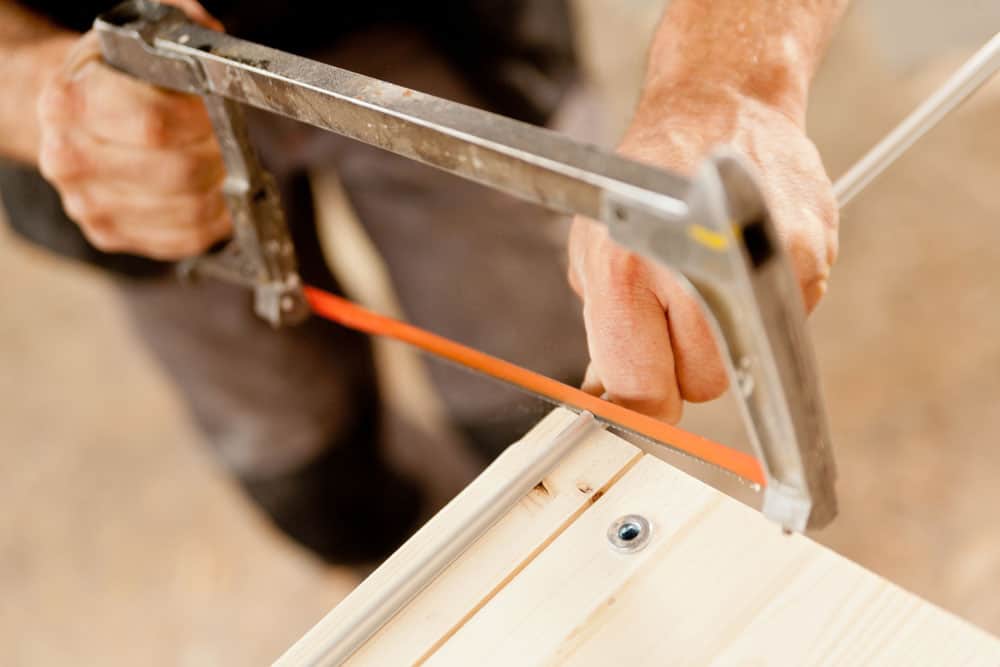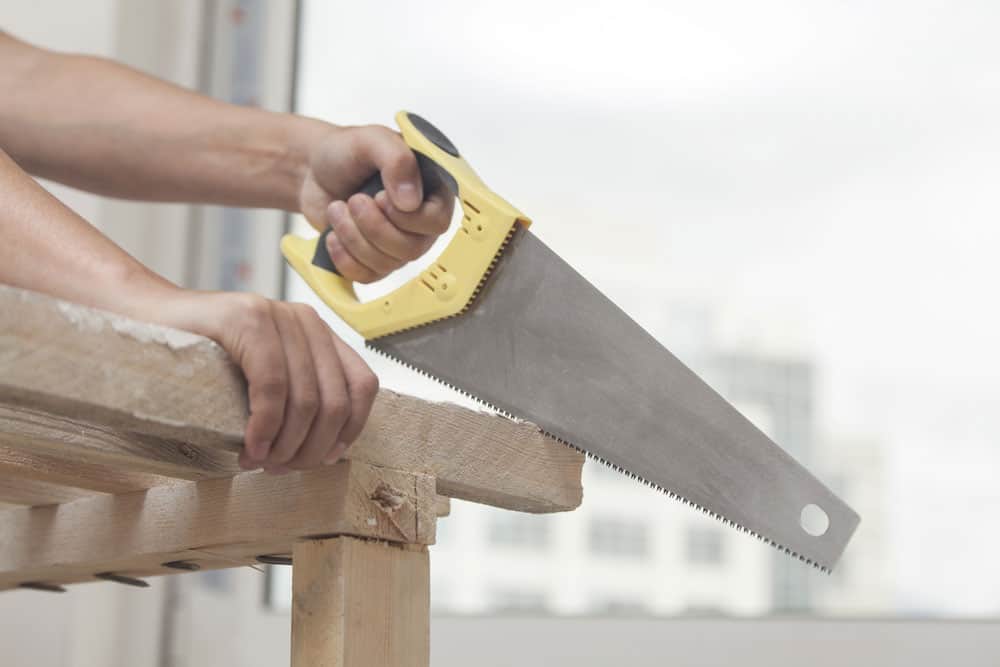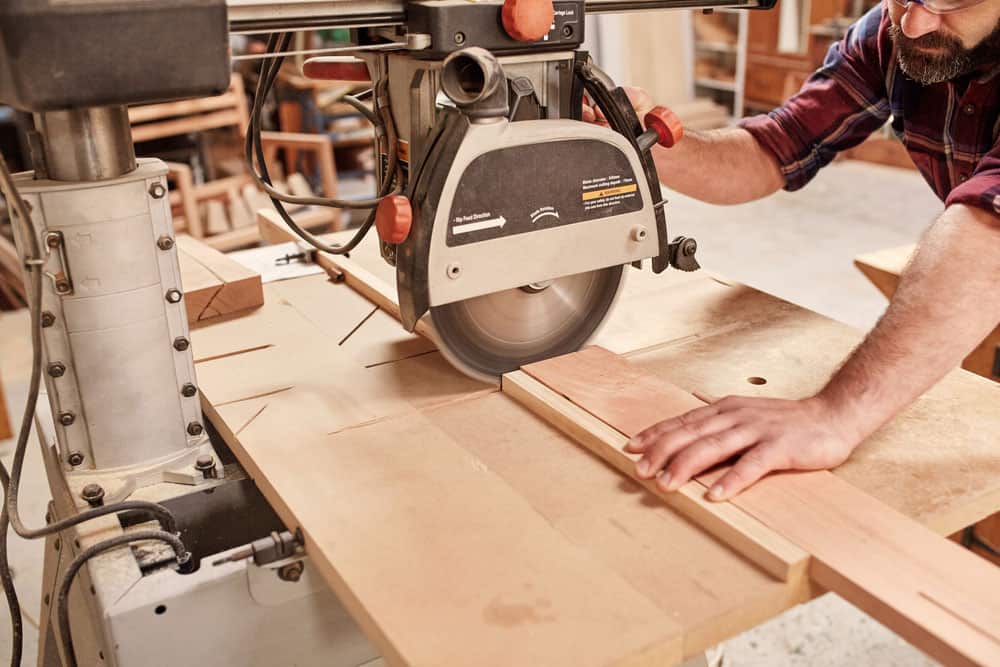Hacksaw vs. handsaw for cutting wood, which one of these manual saws is better?
There are many types of saws on the market, each with its design and purpose.
Hacksaws and handsaws are the most common ones, but what are the differences, and which one is more suited for you?
Handsaws are usually used for cutting wood, while hacksaws are used for cutting plastic and metal.
Their blades are small and narrow, while handsaw blades are larger. While they look similar and operate in the same way, they are very different.
Let’s have a look below.
Hacksaws and Handsaws: The Basics
The main difference between hacksaws and handsaws lies within their uses.
The way you use the tools influences other characteristics of them, such as their blades, size, cutting motion, and more.
Hacksaws- Features and Uses
- Hacksaws have thinner blades.
- Bow-shaped metal frame.
- Used to cut plastic and metal materials.
- The metal frame is adjustable to different blade lengths.
- The blades are made from high-carbon or high-speed steel.
- Tooth density ranges from 14 to 32 teeth per inch.
Uses:
- Electricians use hacksaws to cut metal covers of electric wires.
- Hacksaws can cut and shape metals, making shelves, handles, furniture, etc.
- Plumbers use it to cut gutter pipes.
- You can cut copper and steel pipes.
- It can cut thick or thin metals because the blade can be changed accordingly.
- It can cut a variety of plastic things.

(a hacksaw)
Handsaws- Features and Uses
- It has a special handle shape, no bow shape.
- The handle is made of wood or plastic.
- Has a very thick blade.
- It is less dense.
Uses:
- You can use a handsaw to cut big pieces of wood.
- You can make furniture.
- You can use them to cut shrubs, tree limbs, thick vines, and low-hanging branches.
- Handsaws can make fancy angled cuts in thin pieces of wood.
- Can make holes in electrical piping, fixtures, and outlets.
- Carpenters use a handsaw to cut shapes they trace on wood, drywall, or plywood.

(a handsaw)
The Differences Between the Hacksaws and the Handsaws
If you are all for the traditional way of cutting stuff, you would love to know the differences between hacksaws and handsaws.
These differences will help you choose between these manual saws. Let’s have a look below.
Different Blades
The thickness of the blades of both hacksaws and handsaws are quite different. The blade of the hacksaw is skinner than the blade of a handsaw.
The size is also different, as a hacksaw blade is usually narrow compared to a handsaw.
Apart from their size and thickness, you must also look at their teeth density.
A handsaw typically has 10 teeth per inch, while a hacksaw comes with 3 times the amount, which is 30 teeth per inch. That’s worlds apart!
You would also see that the blades are fastened to the handle in different ways. You can easily take out a hacksaw blade and put another one when necessary.
This is useful in cases where you are cutting lots of materials or the blade isn’t sharp.
However, a handsaw blade is very secure on the handle and cannot be substituted when it gets blunt. You would have to sharpen it.
Materials
Since a handsaw and a hacksaw are used to cut different things, it is common to see them made out of different materials.
Handsaw blades are made from tempered and hardened carbon steel, which gives out clean cuts.
Hacksaw blades are made from high-speed steel, which is a tough type of steel that is suited for tough jobs. It also resists abrasion.
The materials they can cut through are also different. You cannot use a hacksaw for a handsaw’s job and visa versa.
A handsaw cannot cut what a hacksaw can cut (plastic and metal). You’d be wasting your energy and could possibly injure yourself.
While a hacksaw may be able to cut some wood, it would take too long, and the blade may break.
Hacksaw vs. Handsaw for Cutting Wood: Versatility
The hacksaw takes the prize here. You can swap out and change a hacksaw blade whenever you’re cutting something and how smooth you want the cut to be.
All you have to do is unscrew the nuts and carefully swap out the blade.
However, with a handsaw, this is not possible. The blade that comes with a handsaw is the one you’d have to use, so it is not very versatile.

(builders working with tools)
Hacksaw vs. Handsaw for Cutting Wood: When to Sharpen the Blade
Usually, when the blade of a hacksaw gets blunt or isn’t cutting as it should, you can throw it away and simply put in another one.
However, this is not possible with a handsaw. You don’t have to throw the entire handsaw away; you can sharpen the blade.
This takes a long time, though, and you’d need a jointer, a saw vise, and a file with a handle. You would have to sharpen each tooth, which can be tedious.
Hacksaw vs. Handsaw for Cutting Wood: Cutting Motion
This is another big difference between the hacksaw and the handsaw.
While you might think they are both manual saws, they probably use the same cutting motion.
This isn’t true, as a handsaw can work in two motions, while a hacksaw only works on a push action.
A handsaw has a special teeth design, which impacts how smoothly it cuts the material.
You would have to hold the hacksaw pretty steady and level for you to properly cut through the material.
With a handsaw, you can change the angle according to the material you plan to cut.
For example, if you want to cut oak wood to make a cutting board, you can cut it using the handsaw at 60 degrees.
For softwoods, you’d usually hold it at 45 degrees.
The Similarities Between the Hacksaws and the Handsaws
While these manual tools have many differences, they also have much in common. Let’s explore these similarities:
- They are both handheld sawing tools.
- Hacksaws and handsaws do not need electricity, just your energy and a sharp blade.
- They are both replaced by modern power tools, such as laser cutting.
- They both go according to the same safety precaution steps.
- They are both obviously sharp!
- Both hacksaws and handsaws have to be cleaned and oiled regularly.
- With these tools, you must store them in a cool, dry area, so there will be no rust on the blades. Preferably, it would be best if you hung them on the wall of your toolshed.

(cutting wood using modern tools)
Conclusion
Now you know the marked differences and similarities between the traditional handsaw and the hacksaw.
These differences will help you choose the saw you really need for your DIY project or whatever you’re doing, as well as the correct measures to take care of it.
